May 2016 April 2016 >>
Blog of Jack and Jude
explorers, authors, photographers & videographers
Changing Hats Completed
These changing hats are unique experiences, like seeing a new time-frame of the way ahead. As if deadlines have been reset, like we’d just pressed our XTE button and reset the cross track error!
With Banyandah settled, living in the house is becoming a buzz with the nice views and other critters around, a good place to stretch, with a huge shower fed by rainwater, Jude’s already had a go in the rowing machine, and the numerous up and downstairs feel good, so it looks like longer term plans can now proceed.
Our greatest dream was fulfilled on the second last day of May 2016. Three years had passed since our homebuilt yacht Banyandah had lain alongside that very same Ballina jetty fully supplied and with all systems ready to master the new challenges that would take us around Australia again.
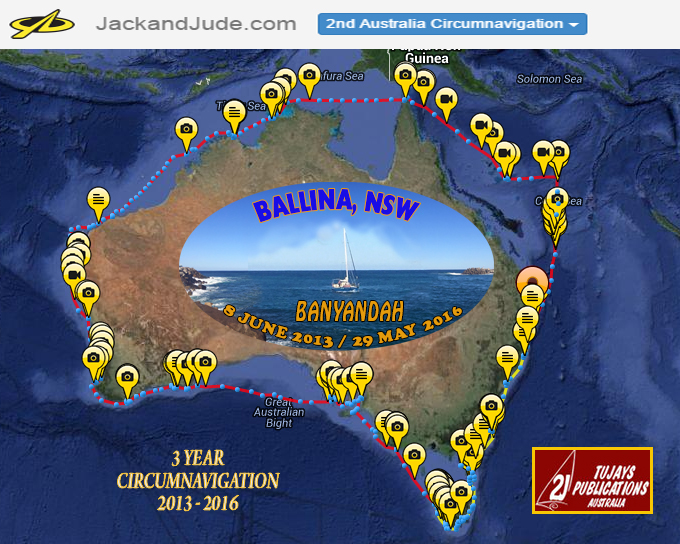 Beyond the river mouth, balmy seas and wild oceans surround this immense continent country. Three years ago on departure night, on board wishing Nani and Poppi bon-voyage were our grandchildren, and that night the dream of exploring Australia’s vast shores, of discovering her beauty and her uniqueness, wonders and treasures was told to those children. Some of them, we could see a twinkling of one day taking on such a challenge themselves.
Beyond the river mouth, balmy seas and wild oceans surround this immense continent country. Three years ago on departure night, on board wishing Nani and Poppi bon-voyage were our grandchildren, and that night the dream of exploring Australia’s vast shores, of discovering her beauty and her uniqueness, wonders and treasures was told to those children. Some of them, we could see a twinkling of one day taking on such a challenge themselves.
And now on the second last day of May 2016 those children, three years older now, witnessed the return of that small homebuilt ship after it had sailed twenty thousand kilometres across every sea surrounding their island country. We are not amazed, but we are very pleased to have completed this journey safely with vessel intact, and satisfied with our achievement as a unit, pretty thrilled in fact, even more so now the children have seen that dreams can come true.
We live in a golden age where even ordinary folk can achieve extraordinary dreams through determination, a bit of courage and a lot of plain hard work. We squeak through without great wealth or intelligence, nor even good looks. By achieving our dream, we have also had the privilege of demonstrating this truism to our blood and brethren, and are forever grateful and humbled that coming from different backgrounds then meeting by chance that we also learnt to put the distractions aside to work as a team even if sometimes out of step. We’ve proved yet again to ourselves that two together is a far more powerful force than two apart. We recommend it.
The last leg of Banyandah’s sail to our home port of Ballina, a two-day jump, was one of immense pleasure, a voyage all sailors dream of having. When we departed Laurieton on the Camden Haven River we were unsure where we’d come in. Before departing, a lot of time had been spent studying Coffs Harbour and Iluka on the Clarence River, checking tide times and condition of entry. We studied four or five different wind predictors, but in the end simply said, let’s see where the wind takes us. With mild troughs and a high moving in, the weather could go one of several ways, add that to the ups and downs of the notorious Ballina Bar, the most dangerous on this coast, we would have been pleased to get as far as Iluka. From there we could motor the last 35nm if need be, when conditions were placid and the bar safe. But, that proved unnecessary. We just kept logging good miles in the variable conditions that came and went, and it was as if our stable horse Banyandah knew she was going back to an easier life alongside in the Richmond River. And the weather played nice, so nice that we arrived well before first light and lay ahull a few miles south of the Ballina Bar. Then we were privileged to watch a sparkling sunny day blossom, while hearing and then seeing humpbacks blow past, while an occasional series of big swells broke across the bar, which thankfully was tame for us. The grandkids and family showed up on the north break wall to welcome us home and we heard cheers and yahoos so loud the Marine Rescue asked us over the VHF if we happened to be royalty. “No, we’re the lucky ones with a great family and a magic boat that can take us anywhere.”
It’s Time ( 20 May update )
Those who follow our travels on the Yellowbrick will know that we’ve been logging quite a few miles lately. After making the decision to take our floating home back to Ballina, our focus zeroed in on finding suitable wind systems to tackle Bass Strait and then the adverse currents and increased shipping found on the New South Wales coast. Bluntly speaking, the Tasman Sea is not our favourite pond of water. Its immense powers silently wait to pounce upon the unwary, and even though we’ve been here before, this time we copped it during our two big jumps. The first, Deal Island to Eden in less than two days of squally, wet conditions. Here’s an excerpt on Benjamin Boyd establishing Boydtown, Eden in 1842.
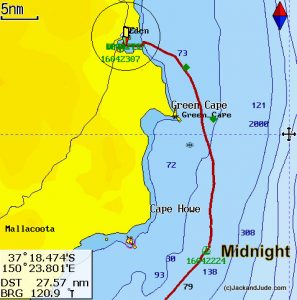
our course line into Eden
Our second jump, from Eden to Pittwater, north of Sydney, again in less than two days, harnessing winds constantly above twenty knots, with a fifty-five blast at the start that flattened us. Wow! What a way to start a voyage. There followed plenty of thirty knots gusting thirty-five before and around Jervis Bay.
But after an awesome week exploring the unique Kuring-gai Chase National Park located on the outskirts of Australia’s largest capital city, we took flight on what was suppose to be a short burst of light westerly wind. Which never blew enough to even ruffle the water and yet Banyandah seemed to glide along on greased tracks, passing through the masses of ugly coal ships waiting to pick up their shipments of poison from Newcastle just as a nearly full moon rose to twinkle off the smooth sea. Instead of stopping at Broughton Island when the breeze was suppose to leave us at dawn, we passed that milestone well before my watched finished at midnight, and then Jude sat watching dolphins play alongside our slippery ship till first light saw us reach Tuncurry. Why pull in, I thought. This breeze might take us along all day for more joyful smooth water sailing. And it did, all the way to Camden Haven, reaching that barred river entrance a few hours after low water. As the sun shone a rosy golden glow behind a darken monolith, we parked our lady off lovely Laurieton, situated under the Big Brother Mountains. Then cracking open a cold one we thought, at last a passage to shout about!
Something far more important
But instead of going on about powerful winds and dodging sea spray while watching for red and green eyed monsters, there is something far more important to write about than another sea saga.
Like each and every one of you, I have my likes and dislikes, my opinions and thoughts. Some of you will like what I write and how I express myself, others will not. As a person who sails the seas using Nature’s forces, a person subjected to its calm beauty and its brute awesome forces, like many of you exposed and subjected to Earth’s majesty, I am deeply saddened to witness Earth’s slow death and know that it is dying on my watch and by our hands.
One of the greatest assets we have as sailors is our camaraderie based I believe on our mutual respect that each of us lives and works under challenging, rewarding conditions, that each of us feels the joy, fear, and pain of limitless horizons. And when we gather we share our stories, we laugh and at times we discuss the dire situation that Earth is in. And like all humans, sometimes we agree and sometimes we do not.
Now then, Jack and Jude have lived a great deal of our seven decades afloat. We have attended many gatherings, told innumerable stories, and heard as many in return, and we have benefited by the gracious giving from other yachtsmen, boaties, and shore folk. But today, more often than not, we prefer to live life afloat alone surrounded by Earth’s majesty without distractions. We’re on a mission from God as the Blue Brothers once said, but not the God that the churches pray to. For living life alone with Earth has given us a different perspective than the one that has presided over the demise of something we love, something far greater than any and all humans.
CSIRO
Cape Grim Air Monitoring StationCarbon dioxide levels continue to rise in cleanest air in the world
Paul Fraser looks at things differently too. Back in the early 70s, Paul came up with the idea of having a library of air. Not because he’s a bit odd – he’s not. He’s doing these things as part of a vitally important science. Working at the CSIRO since 1974, Paul tracks the hole in the ozone layer and studies our changing atmosphere, monitoring all the major greenhouse gases that drive climate change. One of his chief research tools is the Cape Grim Air Archive – the most extensive collection of pristine air samples in the world that are being collected on a remote Northwest Tasmanian cliff top that faces the largest clear span of ocean in the world. It is the least polluted air on Earth.
Not only did Paul help set up the Cape Grim Air Monitoring Station back in the 1970s, but in an impressive bit of prescience, he also realised that at some future stage scientists would be interested in atmospheric gases that could not be measured at the time. And so, since 1978, every three months, researchers collect about 1000 litres of pristine Southern Ocean air and store it at high pressure, to produce the Cape Grim Air Archive. From small samples of ‘vintage air’, it’s possible, for example, to determine the rate of decrease of chlorofluorocarbons (CFCs) in the atmosphere and how the atmospheric concentrations of hydrofluorcarbons – HFCs, the CFC replacements, have grown. More importantly, they also expose the continual growth of carbon dioxide.
Paul has published nearly 250 research papers and reviews, ten of them in the most prestigious of journals: Nature and Science. He was awarded the Nobel Peace Prize in 2007. So he’s no fool and definitely not a pollie spouting alarmist theories. His research provides a scientific basis for efforts to reduce greenhouse gas emissions.
Here is what CSIRO consultant Paul Fraser is saying today: “Air measurements in remote north-west Tasmania are poised to hit a new high of 400 parts per million (ppm) of carbon dioxide within two or three weeks.” As a scientist, he conservatively added that the landmark reading did not bode well for the earth’s climate.
He also says that if we don’t get increasing CO2 under control before we reach 500 parts per million that we’re going to have some very serious climate change problems, and he warned that world leaders needed to take immediate action to prevent the carbon levels rising further this century.
“At the moment, it’s rising at about 3 parts per million per year, so on that sort of time scale it would take another 30 years to reach 500 parts per million.”
Does that mean we can relax until then? Hardly! Jack and Jude says it’s bad and going to get worse everyday.
The primary impact of carbon dioxide is to cause the atmosphere to warm, and Mr Fraser said it is already having a significant impact on the ocean. “When it dissolves in the ocean, it makes the oceans more acidic, a serious problem on life forms in the ocean.” Coral Bleaching, more precisely stated as the killing of coral polyps is already present and growing in magnitude each day.

Effects of Ocean Acidification – It’s killing the coral cells
a: healthy morphotypes (cell forms) observed in ocean samples, b: incomplete growth
Richmond Valentine, billionaire technology tycoon and a computer genius once said in the movie Kingsmen, “When you get a virus, you get a fever, that’s the human body raising its core temperature to kill the virus. Planet Earth works the same way. Global warming is the fever. Mankind is the virus. We’re making the planet sick. A cull is our only hope. If we don’t reduce our population ourselves, there’s only one of two ways this can go. The host kills the virus. Or the virus kills the host. Either way, the result is the same. The virus dies. If we don’t do something, Nature will. Sometimes a culling is a way to ensure a species survives.

Red Alert, life inside the Beijing smog
Let’s turn around this unholy mess
Richmond Valentine ideas are far fetched some will say. Cruel others will think. Inhumane. Well, Jack and Jude have another way to turn this unholy mess around. And it does not rely on getting all the world’s leaders to agree. It comes from the most important roots, the roots of the everyday people, the ones that have always brought about major change. A revolution to change the system.
We are creatures of Earth – first, last and always. Our very being is part of her and upon our death we remain with her. In so many ways, she’s our Creator. And unlike the gods some pray to, Earth is tangible. We can feel her, taste her, smell her. We admire her beauty, respect her power, and are amazed by her wonders. And yet we treat Earth with the disdain of cruel masters.
Rednecks
For those that don’t know, Queensland has the reputation of being the “redneck” state, an unenviable title given during the long rein of one of its leaders who put through development after development overriding every protest without studies or enquiries. During Bjelke-Petersen’s time at the helm, huge tracts of Queensland’s scrub forests were ripped from the Earth by massive bulldozers dragging stud link chain between them. Bjelke liked to quip, ‘You don’t tell the frogs anything before you drain the swamp.’
Today, all of humanity can be classed as Rednecks. Why? Because every informed person knows full well that mankind is destroying wildlife and wild places at a phenomenal rate. And yet, like ostriches, we put our heads in the sand to hide that inconvenient truth because changing our ways will impact upon our standard of life.
Not Doomsday Sayers
We’re not totally at fault here. We are bound to a system that for centuries has helped develop the human empire, but which now after we have conquered ever scrap of land, that system has become a cancer destroying Earth and its creatures. It demands growth and expanding markets, or else the sky will fall in so we’re told. Never mind that we have decimated most other species, polluted our seas, tainted our air, and have impacted the environment so badly that Earth’s climate is changing. The ramifications of this will be far greater than anything we’ve done before. No! Jack and Jude are not doomsday Sayers. We are veteran world travellers who have observed Earth life for more than half a century and have seen the changes first hand.
Like many of you, we have witnessed much of Earth’s beauty. So to those like us with little ones who have not yet had these amazing opportunities, and to all those who love Earth, we ask that you join us in searching for an answer to Earth’s predicament.
What we think
We should speak out with our thoughts, but even more importantly we need to come up with a new management system based on putting Earth First in all our decisions. To do that will require getting the young reconnected to Earth. Take your children out into the wilderness, let them discover the wonders of Earth. If they are small they’ll discover tiny critters and be amazed, they’ll see birds and watch them search for food, hear their song, and understand that they too have a lust for life. They’ll touch trees, feel the roughness of the scrub, and know the hardship of Earth Life.
Earth is God
If we teach our young that Earth is God in the most tangible form, that Earth is the creator of all life, and show them the wonders first hand, they will come to love and respect Earth. And from that, when they’re the ones making the decisions, they will Put Earth First.
Culling
We heard the other day that National Parks are going to cull 90% of the wild brumbies in the Kosciusko National Park because they are pests destroying the fragile ecology. We also know that when a plague of mice destroys our crops we cull them. In fact we cull all pests for the greater good, and so we wonder, why don’t we cull our numbers? Don’t be alarmed. We’re not meaning a ballot system, nothing like that. But we believe in capital punishment, which lately seems to be on the nose as too cruel or, lowering ourselves to those vile and violent ones who exterminate other humans, robbing them of their time on Earth and taking away their companionship to family. Well, it costs mega dollars to house, guard, and feed them, when we could be using that money for a greater good. We say why not use that money to connect the youth with Earth to help prepare them for their task to manage mankind. They will be making the rules in the years ahead, and they should be exposed to Earth’s majesty and her wonders and hardships.
New Population Projections Shatter Earlier Estimates
Earth Camps
Life on Earth is a privilege and getting rid of those vile violent ones that exterminate others is not about a deterrent nor is it about revenge. It’s about using our resources for the greater good. With those funds we could establish Earth Camps where our youth would be taught by experts in practical knowledge pertaining to Earth and her many creatures. Connecting our youth to the great outdoors will stimulate their minds and help make them fit. It will also teach them practical skills that will boost their confidence and self-esteem. All of this will build respect for Earth. Something that seems to be lacking in a world racing towards oblivion.
There is hope
Never give up hope because most of us have witnessed how quickly Earth heals. A few years back we revisited a Coral Sea islet, last seen devastated by cyclonic winds that had shifted the sand island and destroyed life, when we had counted tens of thousands of seabirds dead with broken necks. Over the intervening years, with the increased human fishing presence, on our return in 2013 we expected to not only see dead white coral reefs devoid of fish life, we also thought the air would be lifeless. But we were wrong. Man had reined in its trapping of fish by enacting stricter rules and now patrol those seas to keep outlaw fishing vessels out, as well as establishing Reserves where Nature can regroup undisturbed. As a result, Jack and Jude witnessed the greatest numbers of sea birds we’ve ever seen for a very long time. It was so uplifting to see eggs to hatchlings through to fledglings in such great numbers the skies were darkened. What it meant is that there is sufficient food in the oceans for them to reproduce. Earth heals.
A few things you can do
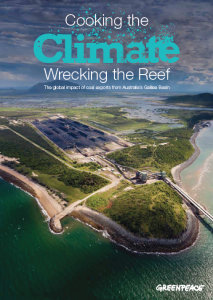 You could join Friends of the Earth to keep abreast of events with like minded folk.
You could join Friends of the Earth to keep abreast of events with like minded folk.
We must stop digging up and exporting our coal. It’s killing Earth. Let us use a renewable non-polluting fuel. Next, we need to add a tax for the damage to Earth’s environment from polluting products and then use that money to fund non-polluting renewable alternatives. It’s only fair.
Along with this, rally the troops. Most importantly the kids. They will inherit the world and make the decisions. We’d love to see another form of management, rather than democracy that relies on growth and panders to the whims of the present folk. So, let’s hear your thoughts because there’s got to be something far greater than what’s happening presently.
Comments and questions welcomed
Homeward Bound
It had been a hard decision between two choices. One was to voyage west through Bass Strait across Northern Tasmania then down its fierce west coast back to Strahan to winter Banyandah there, a distance of 320 nm. Or, cross Bass Strait to mainland Australia and sail north up the NSW coast to our home base, more than twice the distance. Going to Strahan would be easier, but we chose the latter for reasons that became quite clear while secluded in those woods. So we’re homeward bound, on an eight hundred mile voyage across several wind patterns spiced up by notorious adverse currents and plenty of big ships.
With a plan decided, we enthusiastically started watching the weather systems for an opportunity to cross Bass Strait. Since relaunching Banyandah nine years ago we’ve taken her home only twice. There’s been little point when our normal cruising grounds are so far from the Richmond River. Both previous journeys were done in long passages a hundred miles off the coast to avoid the ships and those adverse currents mentioned before. Both journeys had required about seven nights at sea. We prefer the long haul rather than many short hits. For one thing after the first couple of days we’re into the rhythm of the sea and in voyage mode with meals and sleeping, leaving us relaxed, and loving the solitude and Nature. But to do such a long passage successfully requires a large stable weather system, which is more common through winter, while in autumn the systems are smaller, moving through more quickly, changing the direction of the wind from favourable to against.
Studying the forecasts revealed a suitable high pressure cell would reach us in about four days time, so the day after returning to our vessel, in the calm before the wind, we exited Lady Baron to explore Franklin Sound, the strait separating Flinders and Cape Barren islands that is named after Sir John Franklin, governor of Tasmania in the 1840s. It’s a lovely slice of water skirted both sides by untouched mountain ranges, dotted down its centre with uninhabited islands, numerous shoals with overfalls and fast currents a plenty. In any sort of weather it’s dangerous and demands respect, but in calms it’s ideal for delightful adventures. After negotiating those rather testing shoals getting out of Lady Baron, within a few miles we parked close in at Pigs Head Point then enjoyed a kayak along the rocky shores searching the shallows for abalone and crayfish to supplement the small pike we’d caught on the run out of Lady Baron. Two days surrounded by the ever changing scenery of those islands and mountains brought us to Jude’s birthday. All alone I ravished her with big hugs and extra kisses then told her we had to go to work shifting Banyandah out the sound to our departure point. All this as the sun barely lit the horizon because we had to catch the early tide. But I’m a good husband and had brought her a cuppa to get her going before away we went.
Anchored at Babel Island off Flinders’ east coast we had meagre internet coverage which I used to watch the coming weather develop, and the night before our planned departure the weather started looking a bit tight to complete the journey before the winds turned against us. I went to bed uneasy, sleeping fitfully. Hearing eight bells ring at 4 AM, I got up to check the forecasts again. Perusing various sources indicated our passage had gotten even tighter. Supposedly we were to sail across a high pressure cell with light winds that would turn northerly against us. I didn’t like the idea, so my mind went to work on what else we could do, and suddenly I thought of sailing to Deal Island in Bass Strait, a good alternative. We’d be going sideways to the west, but here was a chance to explore the Kent Group, which we’d not done before. So I aborted our passage and let Jude lie in as a sort of belated birthday treat.
Outer Sister and Deal Islands
Next day, using the cloudy westerly flow we had a beautiful easy sail to the northern tip of Flinders and then parked in a notch on the north side of the Outer Sister, a bold rocky island separated from Flinders by a windy three mile passage. Anchoring in deep water surrounded by a shoreline of huge rocks set warning flags flying, so we took the precaution of buoying our anchor before sending it into great depths. It’s something we rarely do, but snagging our precious hook under a rock in twenty metres of water seemed a poor alternative.
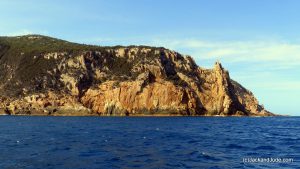 Jude loves these bold uninhabited places and took out her sketch pad. With the wind now around to the east and whistling over the rocky ridge, I was happy just to gaze at the scenery and imagine the early sealers clubbing their prey to death on those rocks that today are of course devoid of those animals. All that night, a penguin colony serenaded us, and gosh can they chatter. Then early next morning after successfully retrieving our hook amidst some worry, we set off with a beautiful north-easterly breeze filling all sail. Ahead we could see what looked like a large island, but which became a tall rock jutting out the ocean. Then after a few hours of fast sailing, Deal Island popped up and quickly grew, becoming impressive with vertical cliffs and jagged ridges that plunged into cobalt blue sea, deep and rich like Bristol Blue Glassware.
Jude loves these bold uninhabited places and took out her sketch pad. With the wind now around to the east and whistling over the rocky ridge, I was happy just to gaze at the scenery and imagine the early sealers clubbing their prey to death on those rocks that today are of course devoid of those animals. All that night, a penguin colony serenaded us, and gosh can they chatter. Then early next morning after successfully retrieving our hook amidst some worry, we set off with a beautiful north-easterly breeze filling all sail. Ahead we could see what looked like a large island, but which became a tall rock jutting out the ocean. Then after a few hours of fast sailing, Deal Island popped up and quickly grew, becoming impressive with vertical cliffs and jagged ridges that plunged into cobalt blue sea, deep and rich like Bristol Blue Glassware.
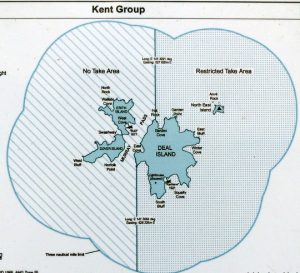 Deal Island is in the Kent Group, a complex of three large islands with a deep channel separating it from Erith and Dover, the two western isles. Our sailing guide quotes Marine and Safety Tasmania, noting that Murray Pass, the channel between, has fast currents and is dangerous with strong winds funnelled through it. This is precisely the situation we experienced after rounding South Bluff. Although while on the passage out we’d had no more than a fair sailing breeze, yet out the channel charged wind driven waves with bullets lifting their tops in swirls and spray. An ominous welcome. But one that soon changed once we had powered through that mayhem to enter East Bay. Under the complex of buildings that formed the caretaker’s residence and museum, and surrounded by rising hills and rocky cliffs, we parked off the supply jetty in pure white sand and soon settled down to soak up the grandiose scenery. A half mile west, Dover and Erith could be seen, both green clad with golden yellow and red rocky points filled in between with long smiling sandy beaches. On turquoise water, the scene so inspired Jude, she began to capture it on paper while I started jotting down notes for this blog.
Deal Island is in the Kent Group, a complex of three large islands with a deep channel separating it from Erith and Dover, the two western isles. Our sailing guide quotes Marine and Safety Tasmania, noting that Murray Pass, the channel between, has fast currents and is dangerous with strong winds funnelled through it. This is precisely the situation we experienced after rounding South Bluff. Although while on the passage out we’d had no more than a fair sailing breeze, yet out the channel charged wind driven waves with bullets lifting their tops in swirls and spray. An ominous welcome. But one that soon changed once we had powered through that mayhem to enter East Bay. Under the complex of buildings that formed the caretaker’s residence and museum, and surrounded by rising hills and rocky cliffs, we parked off the supply jetty in pure white sand and soon settled down to soak up the grandiose scenery. A half mile west, Dover and Erith could be seen, both green clad with golden yellow and red rocky points filled in between with long smiling sandy beaches. On turquoise water, the scene so inspired Jude, she began to capture it on paper while I started jotting down notes for this blog.
The wind system was suppose to pass that night, leaving us with a few days of calm that would be perfect to explore the islands before the next wind system came though. So, while dinner bubbled on the burners, I contacted the caretakers on VHF and arranged to have coffee with them the next morning around ten. Perfect.
I could go on and on describing the wondrous sights and grand hospitality we experienced at Deal and Erith. Suffice to say that Steve and Martina were very gracious hosts who make great coffee and fabulous cookies. And the wildlife. Well! As Jude expressed, ‘Crikey! I feel as if I’m stepping ashore in the Galapagos.’ It really did feel like the Galapagos where the critters have no enemies and few humans to disturb them, they were not afraid. Cute wallabies didn’t budge from their grazing when we brushed past. Gorgeous Flame Robins landed on branches next to us, and cute little White Eyes pecked at insects around our feet after our boots exposed them. And many pairs of Cape Barron geese allowed us within arm’s length. Beautiful creatures, silky grey with a splash of bright yellow across their beaks, they mate for life and are quite devoted like lovers. Their numbers have dramatically increased in the last few decades after a campaign by Parks to teach the islanders how beneficial they are.
Our first day ashore we took a picnic across the island to the tallest plateau to visit the highest lighthouse in the southern hemisphere with an elevation of 305 m. Deal Island light, which is no longer active, once blasted out three flashes every 20 seconds. The light structure itself is a rather squat Doric column of plastered rubble built in 1848, the third oldest in Tasmania. Standing only 20 m in height, it supports a 12’ diameter lens housing a 1000 w tungsten halogen lamp, which gave it a geographical range of 40 nautical miles. Until recently visitors could enter the lighthouse and climb the winding cast iron stairs to the observation platform surrounding the column that sits under the lens, but early last year the light house was closed on OHAS grounds by Tasmania Parks and Wildlife who oversee the island. However the views from the high vantage point are nothing short of spectacular, marred only slightly during our visit by a skerrick of smoke haze drifting in from a bush fire in Victoria.
The second day we took Steve’s advice and walked the 4 kms to Garden Cove then trekked up the open hillside and back along the ridge overlooking the channel. We’d packed another picnic lunch, enjoyed on a rock bluff looking across to West Cove on Erith. It looked very inviting, so off we went, driving our adventure machine across the calm channel later that afternoon, to park her in transparent water over shallow sand. Once again, with the whole shebang to ourselves, straight away in the balmy afternoon stillness I rowed my lady in to search for hidden treasures along the lovely tan beach, followed close behind by the resident pair of geese.
The Voyage
It was dead still all the night before our second planned departure and I woke several times hoping to hear the breath of breeze, but our lonely spot was deadly silent. Arising at first light, around us the loveliest of autumn days was dawning. Mist touched the peaks and filled the valleys, but best of all, our wool telltales were ever so slightly flying off the shrouds in the soft easy puffs that promised more to come. Our normal morning routine followed, listening to dismal and repetitive morning news with hot drinks waking us up, thinking we must be masochist to listen to such a run of mostly negative views on Earth life. Although keen to get an early start, but with only a hint of wind, there didn’t seem a need to rouse Jude from bed even though there were chores and preps still to do. We’d not sail till a sailable breeze ruffled the waters in our bay, and that took much longer than I hoped.
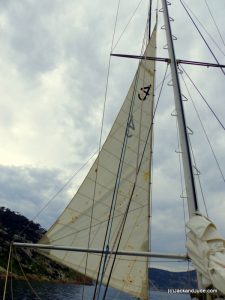 When Jude got up, she sorted her food lockers. At sea everything is harder to do, so she brought to the top foods we would eat over the following 48/72 hours. Coffee, tea, and milk powder canisters were also replenished as well as the bilge area reorganised to withstand the topsy-turvy motion awaiting us ahead. Meanwhile I rigged control lines to Sir Aries, so that we could alter course from the cockpit. I laid out a stout safety line running from bow to stern onto which we could clip our safety harness, giving us access to every part of our ship. Then I checked the engine space, added oil to our rather ancient six cylinder donk, greased the pumps then checked our gearbox linkage as well as all fastenings.
When Jude got up, she sorted her food lockers. At sea everything is harder to do, so she brought to the top foods we would eat over the following 48/72 hours. Coffee, tea, and milk powder canisters were also replenished as well as the bilge area reorganised to withstand the topsy-turvy motion awaiting us ahead. Meanwhile I rigged control lines to Sir Aries, so that we could alter course from the cockpit. I laid out a stout safety line running from bow to stern onto which we could clip our safety harness, giving us access to every part of our ship. Then I checked the engine space, added oil to our rather ancient six cylinder donk, greased the pumps then checked our gearbox linkage as well as all fastenings.
We’d been thinking of trialling an old headsail left from the original ketch rig that had lain dormant in the forward sail locker for so many years. To prepare it, over the last few days Jude had been freeing up and greasing its bronze hanks, that’s the hardware that attaches the sail to the inner forestay. While doing so, Jude raved on recalling memories from our sailing lives with the boys; our 4J sailing motif still attached to that sail, the catalyst. That morning we flew it to see how it fit, and then ran control line ropes to its outer free corner, called the clew. Sailors call the control lines “sheets” from Old English “scéata” meaning the lower corner of a sail. Once rigged and raised I poled it out to check how it would set when in action running down wind.
During all of this, an occasional blast stole down the west facing valley, raising my hopes. But nothing sailable came – only a build up of clouds drifted in, harbingers of the coming front. The day before we’d spoken with our mate Trevor on Tassie’s west coast where the weather hits first and he had told us the front had been a fizzler, not much rain nor wind. News that increased my desire to get an early start. I didn’t want to encounter headwinds at the tail end of our journey nor be forced to motor big miles to avoid them. Passage making in the changeable roaring forties is not cut and dry. What’s grand one moment can suddenly change to horrendous.
Anyways, about noon I felt we shouldn’t wait any longer, thinking let’s go and search for a bit of wind while motoring close to the nearby rock islands to see if we can lure a fish for our dinner. So, easy as, we got our lady going, raised the mainsail and left that magical location, vowing to return again for a longer stay. As it turned out, the swift current was in our favour, and away we zoomed, bound for the Australian mainland across the notorious Bass Strait.
Like riding a bike
Now, many of you will think, oh yeah, they do this all the time, it’ll be a piece of cake. Like riding a bike. But it’s not like that at all. It’s serious business leaving land behind with colliding wind systems about to pounce and mega-sized ships crisscrossing the waters ahead. Sure we’ve sailed a few miles and Banyandah is a good sea boat, but we still have to pull the strings and handle the sails which are gigantic compared to our puny frames, all the time not letting one of those steel monsters run us down. We’re not exactly teenagers anymore, so our energy levels dip. This we try to make up using our nous. But knowledge can do only so much.
An hour after leaving, the wind arrived on the wings of a rain squall putting us straightaway under the hammer. Geez, I hate getting wet. But with a wild boat throwing herself every which way someone had to go on deck to shorten sail. Nightfall came quick and black. So much for the full moon now hidden behind threatening rain clouds. Sure we were now chomping through the miles, but the seas were quickly building as was the wind, every blast adding its lot to the growing onslaught, forcing us to reduce sail until we were down to just a skinny mainsail and partial headsail.
At dusk Jude had gone back aft to try to get some sleep so she could be rested for her graveyard watch starting at midnight. Over the years we’ve always split the night into two, me till midnight, her till dawn. But this night, knowing she wouldn’t be getting any sleep with it being first night out and rolling back and forth as if riding a wild stead, I was thinking of trying four hour watches instead.
The front must have come over us about 7 PM because the rain got serious and the wind started demanding even more respect. Needing to keep tabs on how my ship was handling all these forces, after earlier saturating my first set of togs, I decided to don my antique wet weather gear purchased when I was a skinny kid. Now you might think how un-professional to not have the latest garb, but it costs nearly a grand for a pants and jacket setup which I might only need once every few years. In addition, Banyandah’s protective cockpit, along with her reliable self steering gear, combined with the fact that we usually sail only when conditions are the best, means I don’t need the latest and greatest wet weather gear, even though I would very much like them. A new video camera or a quality drone would be better use for our limited funds. So I struggled into my ancient garb, which is still quite serviceable even if a bit tight around my tummy. And then I struggled into my safety harness over it, which of course didn’t fit with all that extra clobber. But I did it thinking this is what we’re supposed to do to stay safe on a black night in the middle of Bass Strait. That’s what all the informed folk say we ought to do. That’s what the mags say should be done. Saves lives. But I wonder. I’ve been prancing around this deck without a harness since I was a kid protected by her tall stout solid rails, and I find trailing a rope attached to a strong point gets snagged on something and sometimes throws me off balance. Or it just gets in the way when I’m trying to get into position to do something like reef the main. And then I remember that skit between Noah and God when Noah’s bitching about building the Ark, and God’s booming voice comes down from Heaven, “Noah…. How long can you tread water?”
Well, Jude didn’t get any sleep, so at midnight I instructed her to wake me at 4 AM and we’d try four hour watches. Then quick as a wink, because I was wacked, I set up the hammock and jumped in, not expecting to sleep first night out, it being rocky rollie. Jude says I snored up a storm. I wouldn’t know. I didn’t know anything till first light lit the cabin. Lovely it was sleeping in a hammock like that. Woke up steady as if on land and didn’t even know we were rolling about. That’s when I knew I’d had a great sleep.
 Jude on the other hand was wacked. So we traded places, quick as two kisses can take. She jumped into the hammock, unusual for her, but nodded off instantly I’d say, which left me all alone on a windy day that looked to be turning bright, the rain clouds having moved on.
Jude on the other hand was wacked. So we traded places, quick as two kisses can take. She jumped into the hammock, unusual for her, but nodded off instantly I’d say, which left me all alone on a windy day that looked to be turning bright, the rain clouds having moved on.
Day two was glorious. We roared along under a bright blue sky, the miles to our destination quickly diminishing. In fact, so fast I thought about sailing farther on than the first port of call, or slowing down so we didn’t arrive at Eden in the darkness of night.
Jude awoke at noon and we had a lovely afternoon surfing across the waves without one skerrick of land in sight. Without the other knowing, we’d both been thinking about the ‘what ifs.’ Sure we’re getting older and therefore ponder our good fortune, and near misses. Don’t you wonder what the end might be? A runaway truck across a road divide? Heart bursting on a set of stairs? Or a crazed madman and you’re in the wrong place? Well, for us, miles from land, miles from help, it could be a lost container off one of those big ships, or some foreign object cracking open our hull sinking our good lady in a minute. Or, we make a mistake and let a big leviathan monster run us down. Bet they’d not even feel the crunch of wiping out two lives. When crossing an ocean there’s a lot of time to think about these things like that, and mostly we push them right out of our minds. Otherwise we’d not have done anything and the wonderful memories and skills we’ve accumulated, all the moments that have bound us ever so tightly could not have happened. And then we would have squandered this treasure of life. We don’t believe in living as the masses see it. In a square box, fortunate to take memories of achievements and family to the grave. Ours is a different path. We’re all about experiencing Earth. As many nooks and crannies as possible.
That beautiful day continued into my night watch with a full moon rising as the sun went down revealing a plethora of stars. While the heavens morphed we changed sails, dropping the mainsail in case the wind increased. Down to only the headsail made us roll even more, but allowed Sir Aries to steer a straight true course along the wave tops. Down below, wedged in I watched a movie on my device, popping up every ten minutes to make sure we’d not be run down by one of those green and red eyed monsters that seemed to appear every few hours. Up top it was so spectacular. Jupiter shined brightly right beside the moon that climbed higher in a sky filled with every star. A few minutes sucking in all that and I was below again watching “The Martian,” a great flick about what may happen if we don’t destroy Earth with our foolishness because we’re reaching for the wrong goals.
Jude’s watch came as we neared our first point on the mainland at Cape Howe, a place where two currents meet. All of a sudden, like doom was taking over, the wind went ballistic, and the sky which had been clear til that very moment turned black pelting us with rain. With Jude up, we did a rain dance, me prancing around the main deck, shifting the one sail to the other side while she hauled in the sheet. Dog tired, I quit the deck, brushed my teeth, and then climbed into the hammock, glad to be off watch. Jude knowing what to do had a series of waypoints to aim for.
Well, Jude copped the lot. Four ships passed her in one hour. Three on one side, the other inshore. And the rain came back. With blinking lights marking land in the dark night, she kept to the courses programmed into our chartplotter, three changes of direction around Cape Howe, named by Captain Cook. Then Green Cape, all the while I lay back aft in the hammock bobbing back and forth too violently to sleep. I could hear the headsail flog when an occasional stronger blast pulled us higher into the wind, and kept calling out wondering if we were loosing ground to leeward. My concern that we’d find ourselves too far offshore and have to beat to weather in order to make port. She called me an hour before dawn, wanting to climb higher into the wind so we could get into Twofold Bay. We could have sailed on, that wind would have lasted at least another day, but we’d both had enough. Even if we sailed another 80 or 100 miles it was time for a rest.
And so as the eastern horizon just started to lighten, we hauled our wind and raised the double reef mainsail to help climb into the calmer waters of Twofold Bay, home to the port of Eden. Named by Captain Cook when he sailed past the two bays in April, 1770, the first recorded visit by a European was by George Bass in February 1798 when he took shelter in the bay on the return journey from exploring Bass Strait in a whaleboat. He named the place where he sheltered “Snug Cove,” the name by which the bay below the town of Eden is still known. In 1843 Benjamin Boyd purchased land in Twofold Bay with the aim of transporting cattle from the district. Soon afterwards, Boyd started to build the Seahorse Inn adjacent to what is now called Boydtown Beach, which is where we we’re heading to find shelter from the strong southwest wind.
We have visited Twofold Bay three times before. Twice anchoring in front of the restored Seahorse Inn on the south side of the bay, and once, on our first visit in 1978, in Snug Cove.
It looks like the weather will be against for at least the coming week, nothing but northerlies, which will give us plenty of time to explore and take in the changes since then.
Till next, wishing you fair winds and safe anchorages.

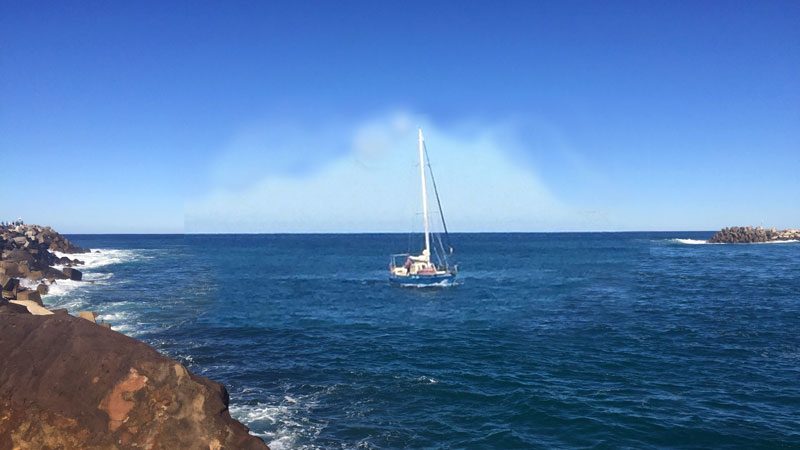
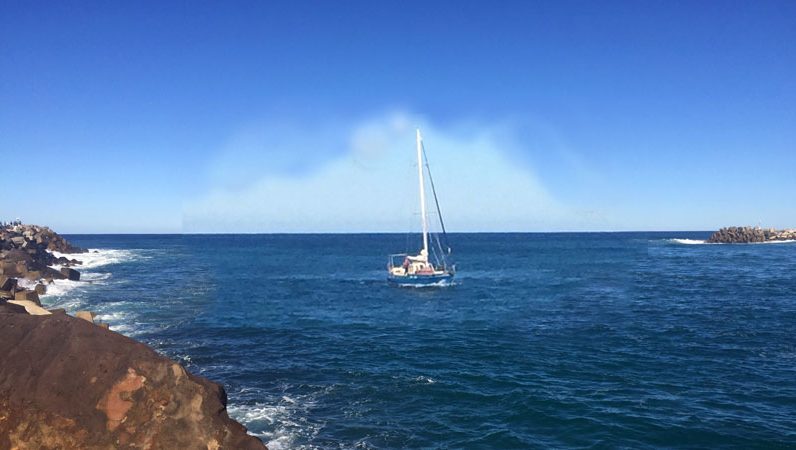
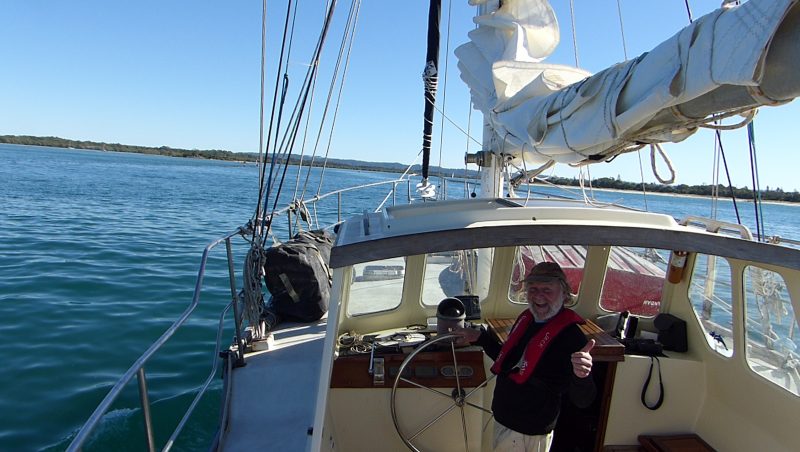
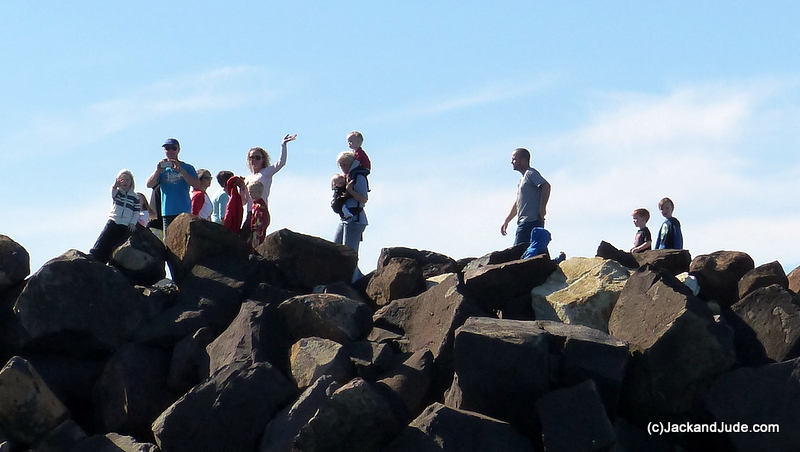
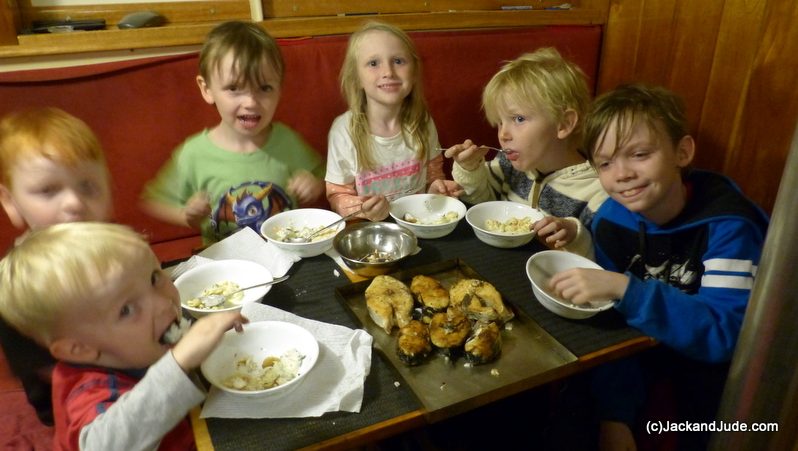
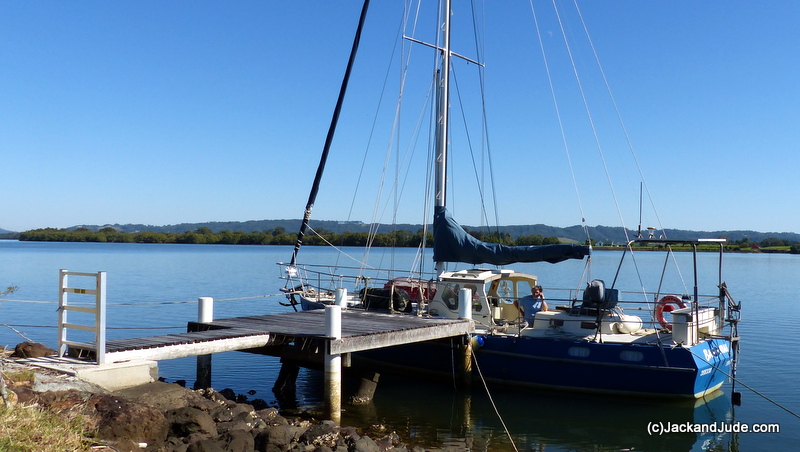

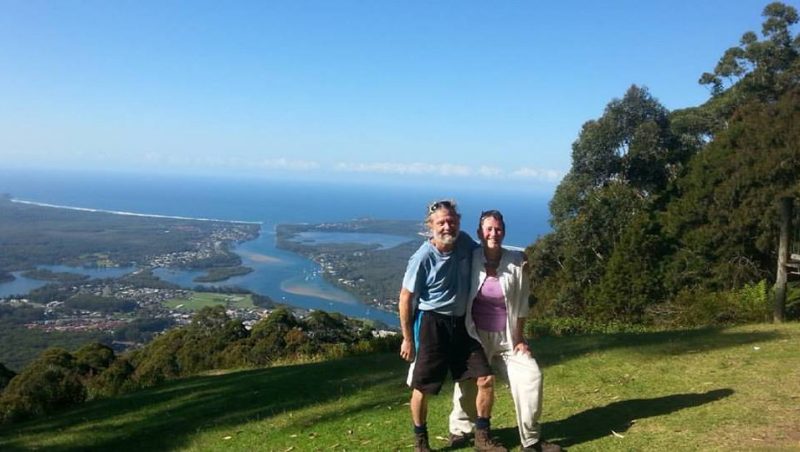



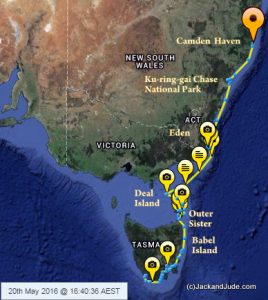
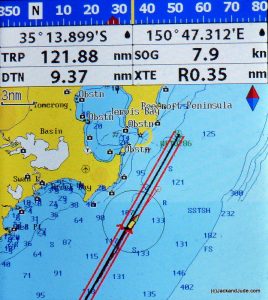
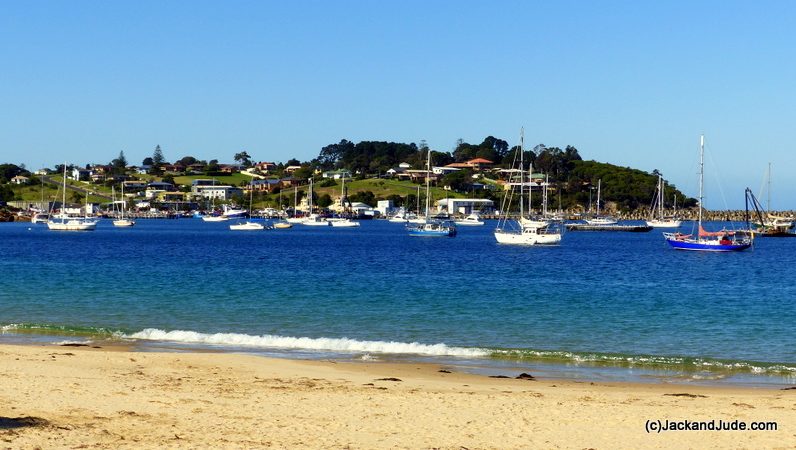

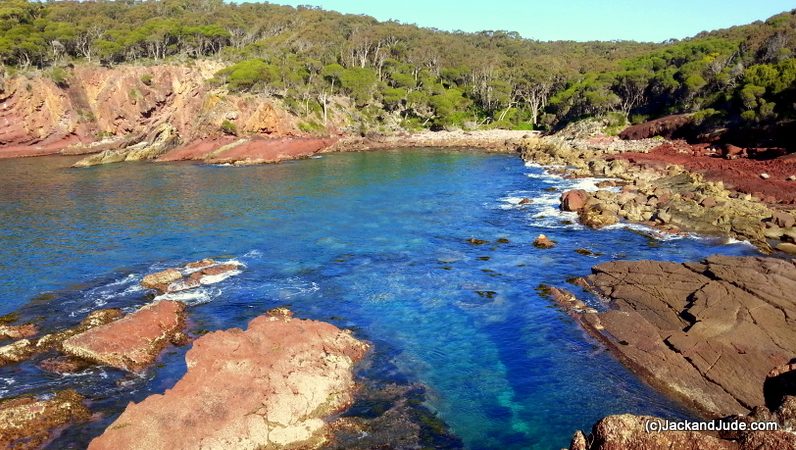
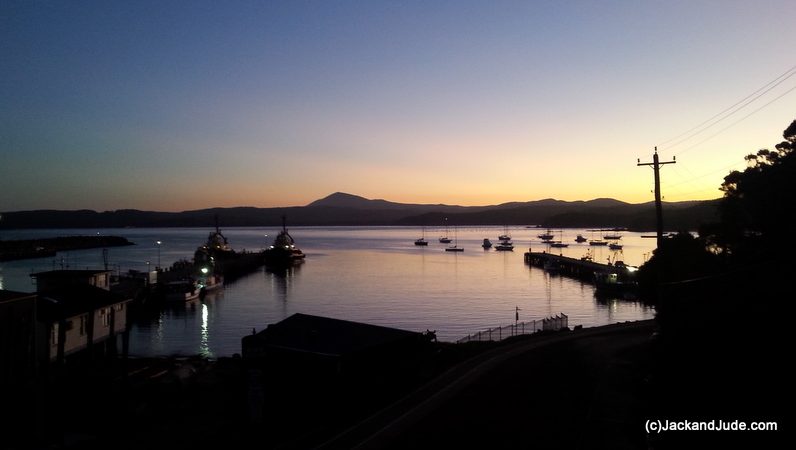
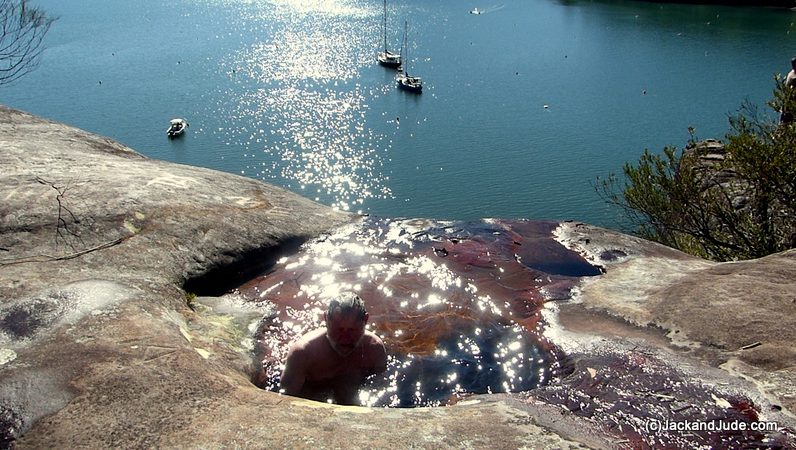
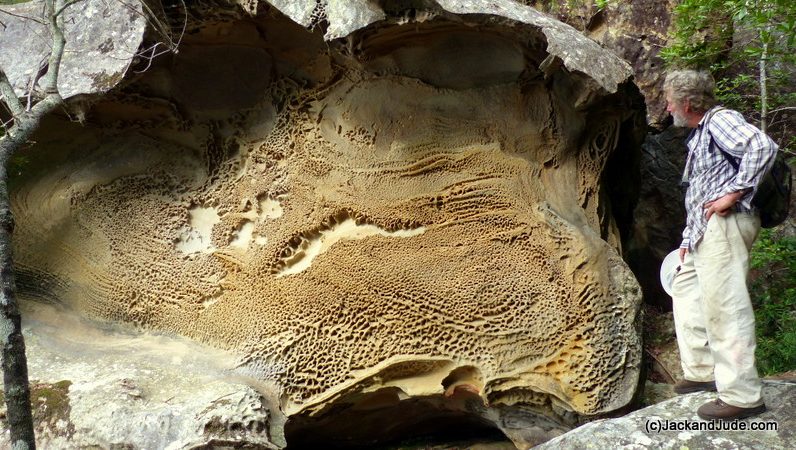
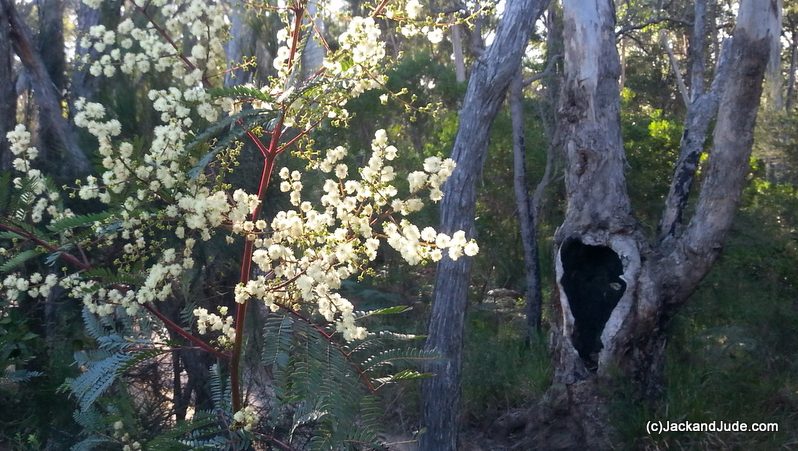
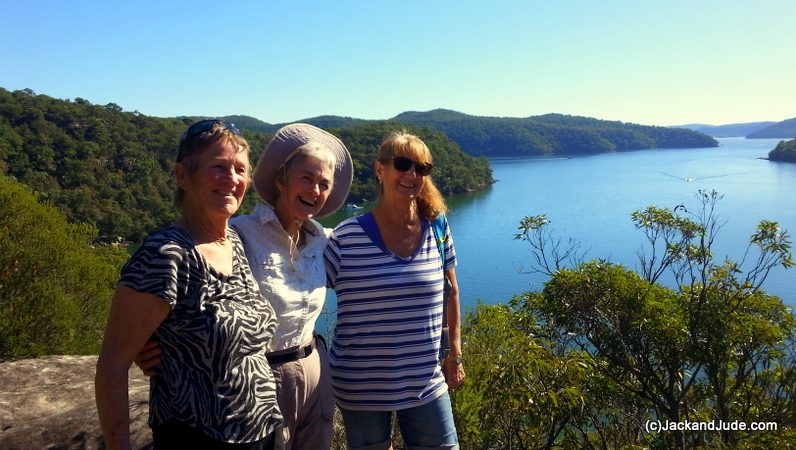
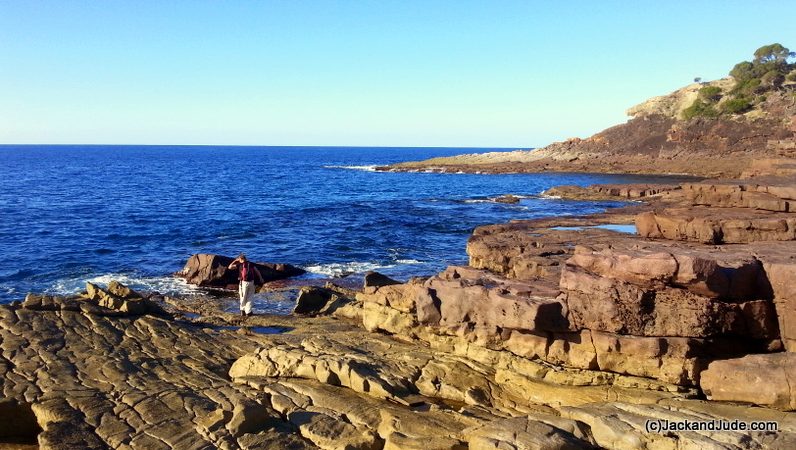



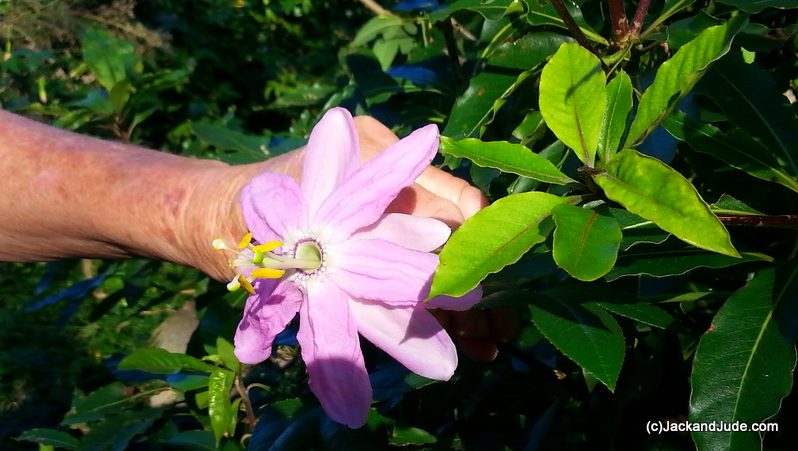
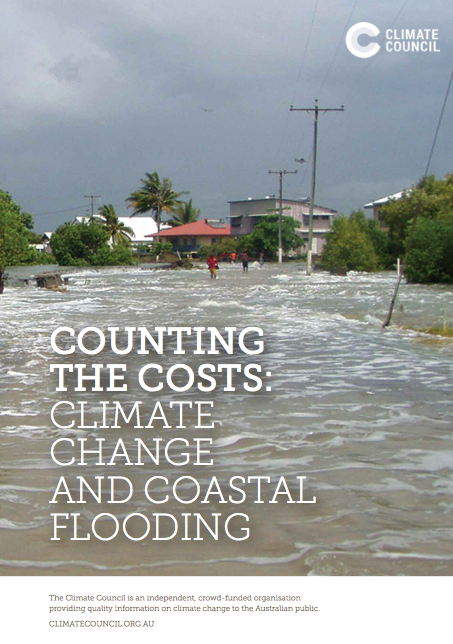

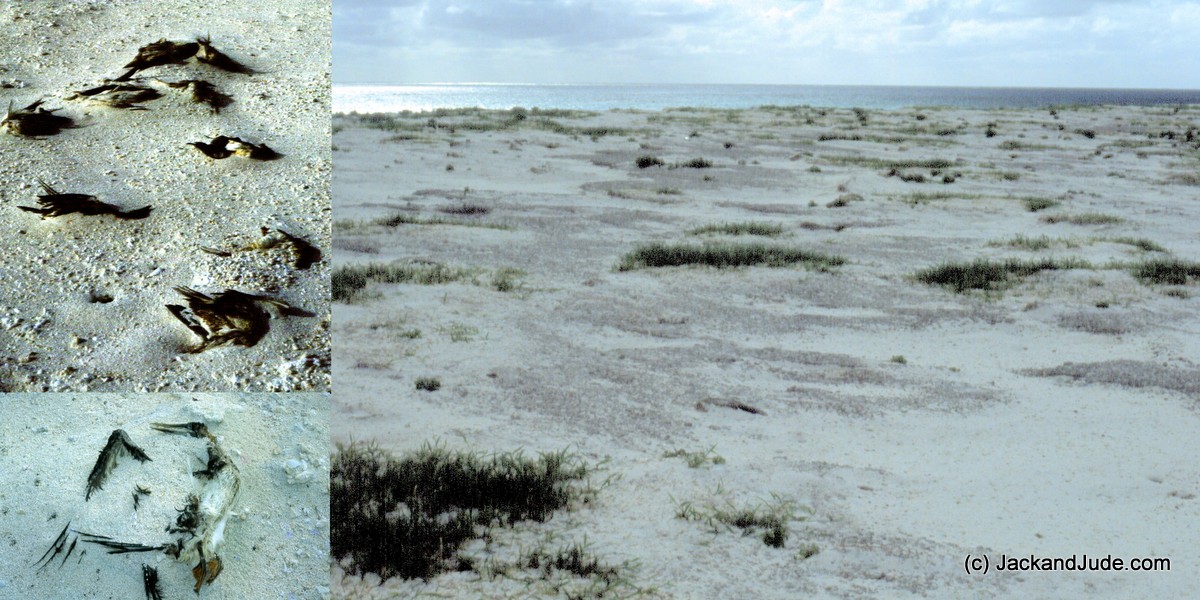


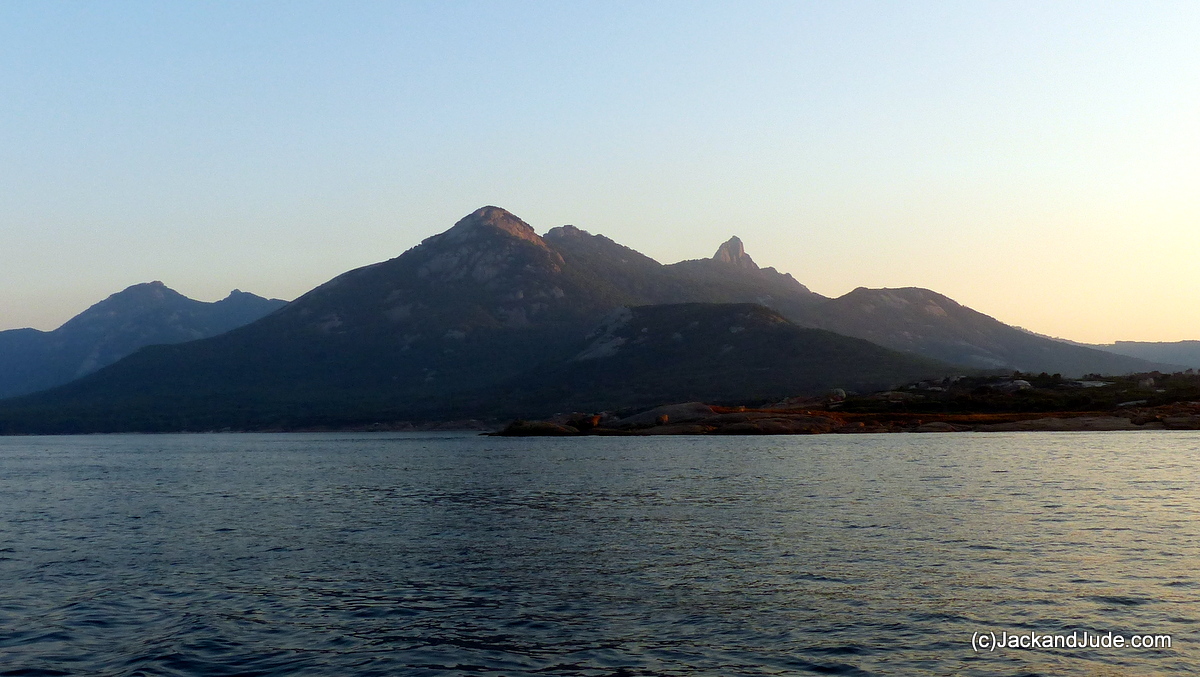
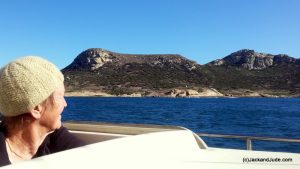
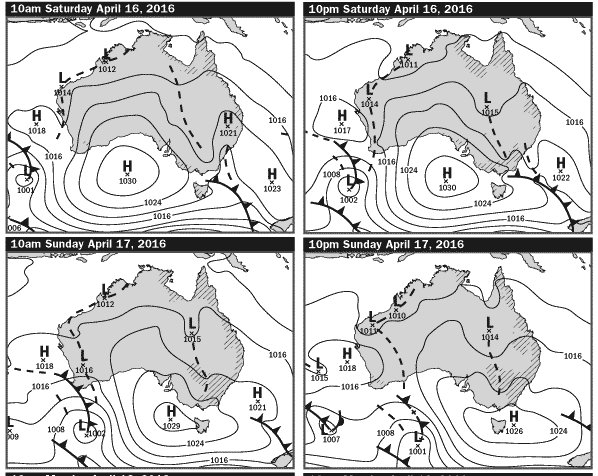
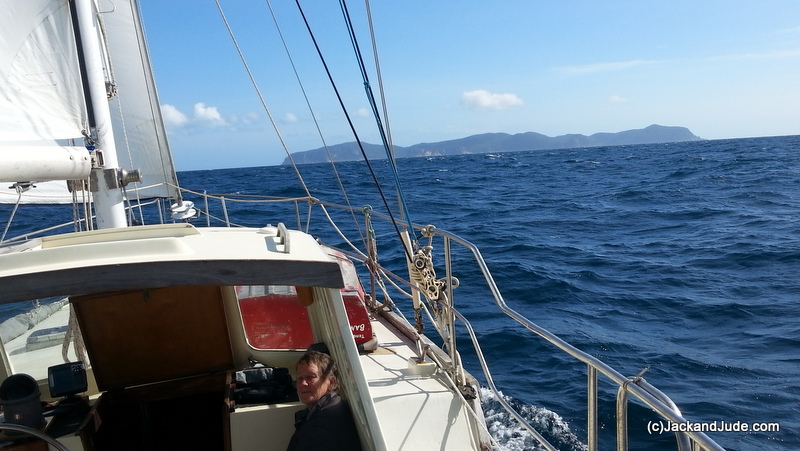
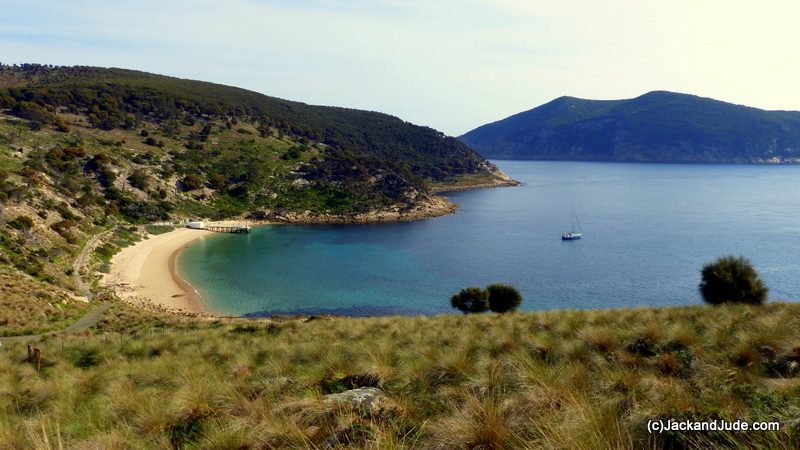
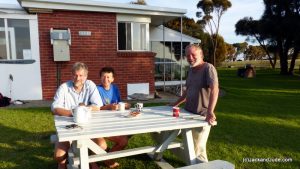
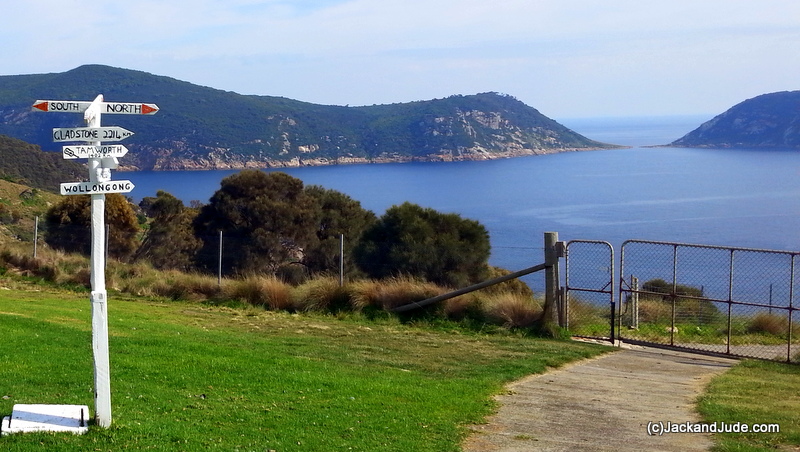
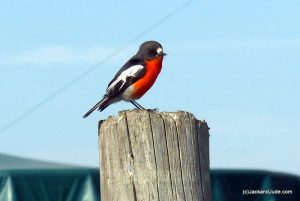

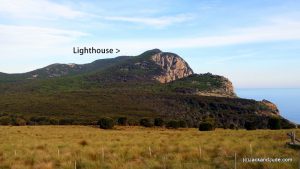

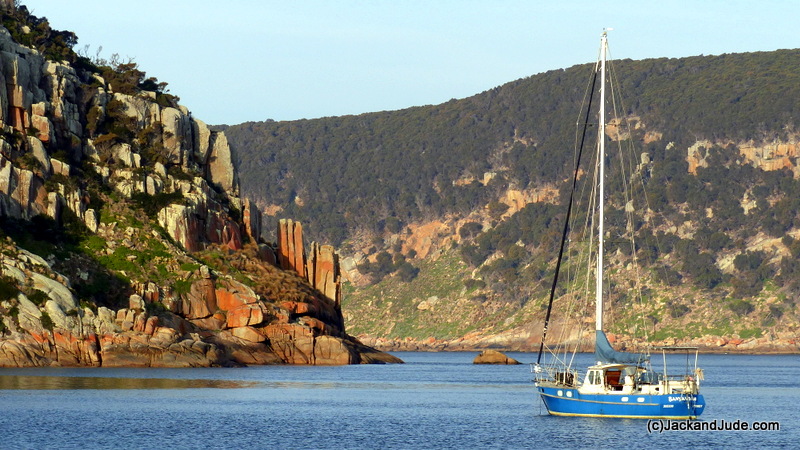
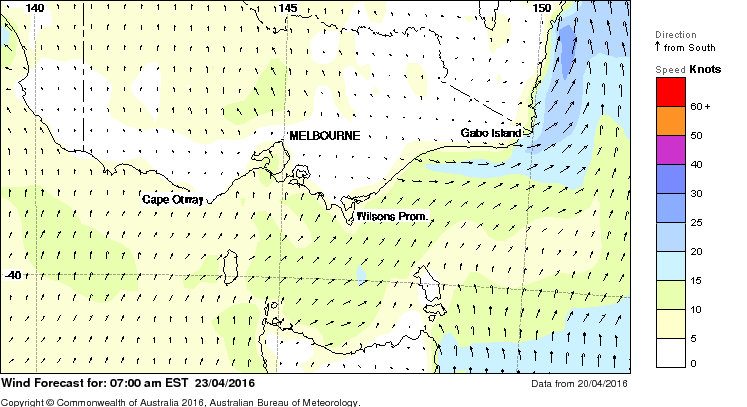
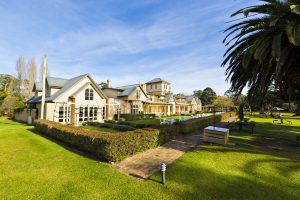
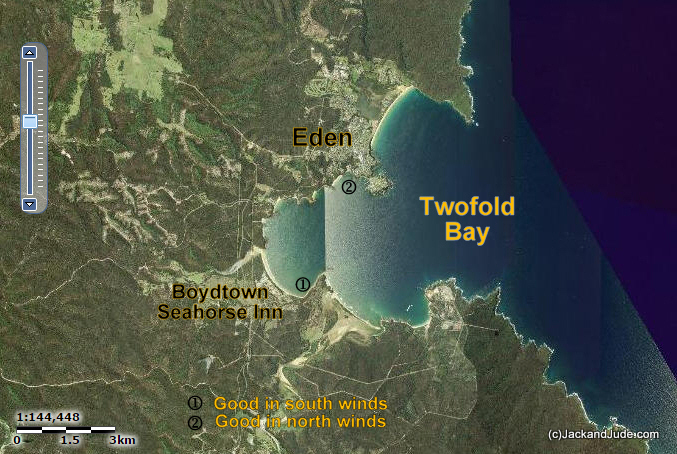




Dear Jack and Jude,
Great to finally meet you both in America Bay this morning and thanks so much for having me aboard your beautiful boat!
If you ever come into Gosford we would love to have you over for dinner, we are only 10 mins walk from the water.
I hope that one day we can share and inspire others as you have with us.
Kind regards,
Gil
Loved your visit. Early morn in a kayak with a lovely loaf of special bread and full of support for what we do. Of course. now we’re mates forever. Simpatico as the Spanish say. On our way south we’ll have more time to visit. Goodonya Gil. Remember what we said about reconnecting the young to Earth. We’ll see you and Lisa in some far away anchorage for sure.
Dear Jack and Jude
So impressed with your zest for living life on the ocean and land. You open up a whole new world embracing nature. An inspiration to all, you write with authenticity and from the heart. Hope one day to meet you both at the wooden boat festival in Hobart.
Cheers
Greg & Chris
Thanks, that was nice of you. Love doing this and very pleased you’re enjoying it. Think we just might be in Hobart for the next festival – watch this space :>)